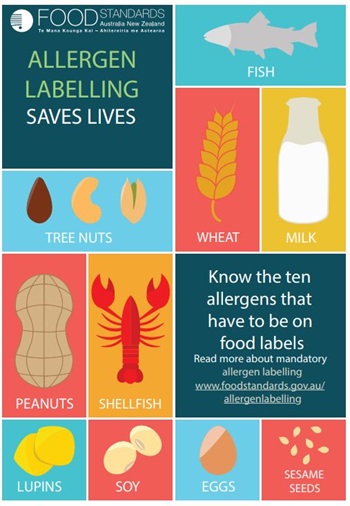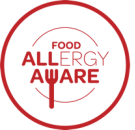Home
Food allergen declarations for food businesses
Food allergen declarations for food businesses
Proprietors and food handlers who work in a wide variety of food businesses such as a cafe, take-away, restaurant or in a food business selling unpackaged foods such as sandwiches, loose bread rolls, cakes and deli products must know the law when it comes to food allergies and food allergen declarations.
Why food allergy matters
When someone has a food allergy, eating the smallest amount of food can be life-threatening. So, if you serve food to customers who have informed you that they have a food allergy you need ensure you provide them with accurate information so they can make an informed choice about level of risk.
Attending to a customer’s food allergy request is legally required under the Food Act 2008. It can help build customer loyalty and be good for business.
Consumers have a legal right to receive, on request, written or verbal information on allergen content when buying takeaway foods or eating out.
|
Goal of food allergen declarations
Protect food allergic customers from food allergens by providing accurate information about the ingredients in the food and avoiding cross contamination in the food sold by:
- Declaring the presence of allergens on food packaging
- Where the food is not required to be labelled, allergens should be:
- Identified when displayed or
- Declared to the purchaser upon request
- Managing food preparation and display to prevent cross-contamination
- Thoroughly cleaning and sanitising equipment and work areas
|
Which foods can cause a problem?
Foods that most frequently cause allergic reactions include: 
- Crustaceans (shellfish) and their products
- Egg and egg products
- Milk and milk products
- Peanuts and peanut products
- Sesame seeds and sesame seed products
- Soybean and soybean products
- Fish and fish products, except for isinglass derived from swim bladders (clarifying agent in beer and wine)
- Tree nuts and tree nut products other than coconut from the fruit of the palm Cocos nucifera
- Lupin and lupin products
- Cereals containing gluten and their products, namely, wheat, rye, barley, oats and spelt and their hybridised strains (other than where these substances are present in beer and spirits or glucose syrups (with removal of gluten protein that does not exceed 20mg/kg) or alcohol distilled from wheat)
- Added sulphites in concentrations of 10 mg/kg or more.
More than 90% of serious reactions are caused by these foods. These must be declared. Cereals containing gluten and added sulphites must also be declared.
Other foods can cause allergic reactions including:
- poppy seeds
- mustard seeds
- kiwifruit
- avocado
- banana
- rice
- legumes (chickpeas, beans, lentils, peas etc.)
- spices and
- many others.
Although mandatory labelling does not apply to these foods, food businesses still need to be able to provide accurate information about the ingredients in foods or meals.
If you prepare food or cook a dish to order, you should be able to identify what has gone into it. Use the recipe, ingredient labels and information provided by your suppliers to understand what allergens are present and what allergens may be present. Remember even the smallest trace amount of certain allergenic foods may trigger a severe reaction in the most sensitive people. So do what is manageable to reduce the risk of trace amounts being present from cross-contamination from food handlers, food surfaces, contact with other foods, utensils and equipment used for other dishes.
Tips for food businesses on food allergen declarations
9 tips for food businesses on food allergen declarations
| Plan |
Have a plan in place to cater for customers who phone ahead or ask at the counter/table whether a food is free of a particular food allergen, or whether the chef can accommodate their allergen avoidance requirements |
| Be accurate |
If you list food allergen ingredients on a card, label or menu, make sure this information is accurate and up to date |
| Traces of food allergens |
When making food, ensure you know what is in all of the ingredients you use, including cooking oils, dressings, stocks, thickeners, toppings, sauces and garnishes. In addition, you can’t simply take out the pieces of food allergen |
| Hidden allergens |
Foods containing allergens are not always obvious. For example, hummus usually contains ‘tahini’, which is made from sesame seeds, and Macadamia nuts have been found in mashed potato. |
| Never guess |
If someone requests food that does not contain a certain ingredient, never guess. Always check the ingredients carefully and follow the food business plan for dealing with customer allergen avoidance requests. If you are still uncertain, inform the customer. |
| Hygiene |
If you are making food for someone with a food allergy, make sure your hands are washed thoroughly before preparing that food, wear a clean apron, and ensure work surfaces, equipment and utensils have been thoroughly cleaned |
| Training |
Train all of your staff particularly food handlers about food allergies and the consequences of allergic reactions. Inform staff what to do when a customer asks about allergens in food. Specify which staff members can give the customer the information they need, or talk to the customer about foods they can eat from the menu. Employee awareness and training is critical to avoid consumers with food allergy being exposed to the unintentional or undeclared presence of allergens in a product |
| Always check ingredients |
Always check the ingredients before you start preparing food for someone with an allergy, as recipes and products can change. If ingredients do change, make food handlers aware and make sure written records are up-to-date. Make sure whoever prepares food understands there may be other names associated with food allergens, such as milk products labelled as ‘whey’ |
| System for ordering |
Ensure a clear system exists ‘front-of-house’ for marking an order to notify the chef and other food handlers that a meal needs to exclude particular food allergen(s) |
Free online allergen training for food businesses

Training is required to make sure staff are aware of the responsibilities of the food business regarding allergen declarations. It is advisable to provide training for all staff. Consider:
- What a member of staff should do when a customer asks for a meal that does not contain a particular food. Training sheets that set out what a member of staff should do are also useful.
- That staff understand that it is important to listen to customers.
- Where staff are unsure whether a meal contains particular food allergen, make sure they know that it is safer to tell a customer that they do not know if the meal contains that food allergen. Never guess.
- If low literacy skills are an issue for your staff, ensure that adequate verbal training and supervision is provided so that staff understand their responsibilities
Food Allergy Aware (external site) offers free online training courses developed to help everyone working in food service, from the manager through to the food preparation and food service staff. The training will help staff to be aware of the risks food allergy poses, help identify and manage food allergens and provide help on how to respond to enquiries from customers with food allergy. Training is available for:
- general food service
- hospitals and healthcare
- camps
- children's education and care food services
- schools.
Food allergy training videos
Food Allergy Aware (external site) has produced a range of educational videos including:
- which foods cause allergic reactions
- using a Chef Card
- how to complete a food allergen menu matrix
- managing food allergies with buffet style service
- food allergen management when storing foods
- food allergen management in the kitchen
- managing cross contamination of food allergens
- using tea towels
- wearing gloves.
Allergen matrix tool
Consider the use of an allergen matrix tool to work out what allergens are present in a meal/food. An allergen matrix is a table that has a list of food allergens, and added sulphites, at the top of the table. Refer to the Food Allergy Aware website for an example food allergen menu matrix tool (external site).
Allergen resources for food businesses
Useful resources for the most common food allergens are a useful guide for dietary avoidance of a specific food allergen and are available from:
- Retail/food service – allergen investigation checklist
- Manufacturing sector – allergen investigation checklist imported
- Food – allergen investigation checklist.
Last reviewed: 16-03-2022
Produced by
Environmental Health Directorate